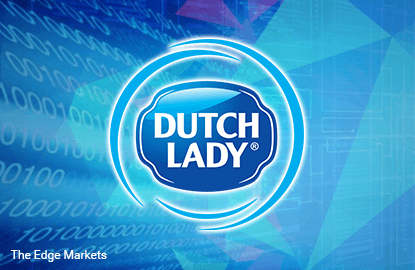
This article first appeared in The Edge Financial Daily, on November 18, 2015.

Stability In Consumer F&B
HAVING looked at the instant coffee sector, we now turn to the dairy industry in our last piece of the F&B series. The three leading players in Malaysia’s dairy industry are Nestle Malaysia Bhd, Fraser & Neave Holdings Bhd, and Dutch Lady Milk Industries Bhd.
These companies are principally domestic-oriented. In FY2014, Nestle and F&N derived 79% and 61% of total sales from the local market, respectively, while Dutch Lady generated most of its earnings within Malaysia.
Despite moderating private consumption growth, dairy manufacturers are less susceptible to economic cycles, thanks to a strong captive domestic market and relatively inelastic demand. Positively, milk powder prices, which have hit multi-year lows amid the global commodities rout, have helped to boost bottom line and margins — offsetting the negative impact of the weak ringgit.
Indeed, in the latest earnings releases, dairy businesses reported an expansion of margin on the back of modest growth in sales (see table 1). In an extreme case, F&N’s dairies division recently reported a staggering 158.5% jump in operating profit, compared with the modest 8.8% increase in sales.
With low beta and stable dividend income (see table 2), these stocks offer relative stability in an increasingly volatile stock market. All have a good track record of paying dividends on the back of steady operating cash flows. Dutch Lady sports the highest dividend yield at 4.6%.
Compared to REIT, utility, tobacco and other non-cyclical sectors, the local dairy sector provides better long-term earnings growth potential, driven by the country’s economic and population growth as well as shifting consumer preference to more convenient and healthy food.
Moreover, their margins are protected by strong economic moats. There are high barriers to entry such as huge upfront capital outlay, time to build brand trust and market share.
Case in point, although we saw F&B packaging companies Can-One Bhd and Johore Tin Bhd moving upstream to dairy products manufacturing, they largely operate in lower margin canned milk product segment with most of their products exported to other Asian and African countries.
To put things into perspective, Nestle, F&N and Dutch Lady reported steady growth between FY2005 and FY2014 and recovered swiftly from the 2008 global financial crisis. Notably, in the past 10 years, earnings growth have outpaced revenue growth — boosted by economies of scale, better sales mix, and continuous product innovation.
Of the three leading players, we pick Dutch Lady as our preferred exposure to the still expanding local dairy industry, given its comparatively higher dividend yield and favourable growth prospects.
The company, the smallest amongst the three, grew at a faster clip compared to its bigger peers Nestle and F&N (see table 3). Revenue increased at a CAGR of 9% while net profit expanded by a quicker pace of 17%.

Dutch Lady Milk Industries Bhd
DUTCH Lady (Fundamental: 2.3/3, Valuation: 1.5/3), one of the country’ top three dairy products manufacturers, offers investors a comparatively defensive investment with higher-than-market average yields in the face of slowing economic growth and market uncertainties. Indeed, the low-beta stock has outperformed the broader market, up 5.3%, since our recommendation back in early June.
With steadily growing operating cash flows and minimal need for capital expenditures, Dutch Lady is a cash cow that keeps giving.
Its shares started a bull run in 2012, when it declared a bumper dividend of RM2.60 — to return huge cash pile accumulated in prior years to shareholders.
Dutch Lady lowered dividends to RM2.20 per share in 2014, from RM2.60 in 2013, mirroring weaker earnings. Nonetheless, this still translates into a superior yield of 4.6%, compared to 3-3.2% offered by its larger peers Nestle and F&N.
Dutch Lady has paid out RM1.10 in dividends, so far this year, and should declare a final dividend by this month-end. We believe it can sustain current dividend level, at least, for the next few years given its debt-free balance sheet and net cash of RM118.8 million.
For 2Q2015, net profit doubled y-y to RM48.8 million on the back of a modest 3.8% growth in revenue, bolstered by lower milk-based commodity costs and the relaunch of Dutch Lady Children Formula Milk. For 1H2015, net profit jumped 39% y-y to RM65.8 million, or equivalent to 60% of last year’s total net profits.
Milk powder prices are seen to remain soft in the coming quarters amid global supply glut and slowing growth in China, the world’s biggest importer. Hence, we expect margins to recover in 2015 even though its top line might suffer in the near term, due to weaker domestic consumption.
The stock is trading at a trailing P/E of 23.8 times, just a shade lower than its 3-year average of 24.3 times. The premium valuation reflects the strong fundamentals of a high-quality, dividend-paying F&B stock.
